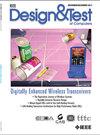Guest Editors' Introduction: Silicon Debug and Diagnosis
引用次数: 0
Abstract
h TROUBLESHOOTING HOW AND why circuits and systems fail is important and is rapidly growing in industry significance. Debug and diagnosis may be needed for yield improvement, process monitoring, correcting the design function, failure mode learning for research and development, or just getting a working first prototype. This detective work is, however, very tricky. Sources of difficulty include circuit and system complexity, packaging, limited physical access, shortened product creation cycle, and time to market. New and efficient solutions for debug and diagnosis have a much needed and highly visible impact on productivity. This special section of IEEE Design & Test includes the extended versions of the three best contributions presented at the Silicon Debug and Diagnosis (SDD) Workshop, which was held in Anaheim, CA, USA, in November 2012. It was the eighth of a series of highly successful technical workshops that consider issues related to debug and diagnosis of semiconductor circuits and systems: from prototype bring-up to volume production. The first paper, ‘‘Linking the verification and validation of complex integrated circuits through shared coverage metrics’’ by Hung et al., discusses how to bridge pre-implementation (commonly referred to also as ‘‘pre-silicon’’) verification to postimplementation validation in an emulation environment. Considering the inherent flexibility offered by field-programmable gate arrays (FPGAs), the authors discuss howembedded instrumentation can aiddata acquisition and coverage measurement in FPGA designs. The evolution of FPGA trace collection methods is elaborated, showing how recent tools can facilitate a set of predetermined cover points to be observed without requiring recompilation. Further, recent research is aimed at enabling any cover point to be measured in FPGA prototypes. In the second paper, entitled ‘‘Evolution of graphics Northbridge test and debug architectures across four generations of AMD ASICs,’’ Margulis et al., present the evolution of the design for test and debug (commonly referred to as DFx) architectures over four generations of AMD designs. The paper covers different aspects of DFx, ranging from scan architecture to control (centralized, modular, hierarchical) to debug buses (asynchronous/synchronous, source synchronous). The key points are that DFx methodology must be physical-design friendly and account for high clock frequencies, needed to acquire and dump the trace data, as well as be aware of the power savings features, such clock and power gating. In the last paper of this special section, entitled ‘‘Deriving feature fail rate from silicon volume diagnostics data,’’ Malik et al., address the challenge of identifying layout geometries that lead to systematic yield loss. As the subwavelength lithography gap continues to widen, this class of defect is becoming an increasingly dominant source of failures. With design-for-manufacturability (DFM) tools, it is possible to identify potential weaknesses in a design, but it remains extremely difficult to assess which DFM features will actually cause yield loss. The authors of this paper present a methodology to quantify the客座编辑简介:硅的调试和诊断
排除电路和系统故障的方式和原因非常重要,并且在工业意义上正在迅速增长。调试和诊断可能需要用于良率改进,过程监控,纠正设计功能,研究和开发的故障模式学习,或者只是获得一个工作的第一个原型。然而,这项侦探工作非常棘手。困难的来源包括电路和系统的复杂性、封装、有限的物理访问、缩短的产品创造周期和上市时间。用于调试和诊断的新的高效解决方案对生产力产生了非常需要和非常明显的影响。IEEE设计与测试的这一特殊部分包括2012年11月在美国加利福尼亚州阿纳海姆举行的硅调试与诊断(SDD)研讨会上提出的三个最佳贡献的扩展版本。这是一系列非常成功的技术研讨会中的第八次,这些研讨会讨论了与半导体电路和系统的调试和诊断相关的问题:从原型开发到批量生产。第一篇论文,“通过共享覆盖指标连接复杂集成电路的验证和验证”,由Hung等人撰写,讨论了如何在仿真环境中连接预实现(通常也称为“预硅”)验证和后实现验证。考虑到现场可编程门阵列(FPGA)提供的固有灵活性,作者讨论了嵌入式仪器如何在FPGA设计中帮助数据采集和覆盖测量。详细阐述了FPGA跟踪收集方法的演变,展示了最近的工具如何能够在不需要重新编译的情况下促进一组预定的覆盖点的观察。此外,最近的研究旨在使任何覆盖点能够在FPGA原型中进行测量。在第二篇题为“四代AMD asic的图形北桥测试和调试架构的演变”的论文中,Margulis等人展示了四代AMD设计中测试和调试(通常称为DFx)架构的设计演变。本文涵盖了DFx的不同方面,从扫描架构到控制(集中式,模块化,分层)到调试总线(异步/同步,源同步)。关键的一点是DFx方法必须是物理设计友好的,并考虑到高时钟频率,需要获取和转储跟踪数据,以及意识到节能功能,如时钟和电源门控。在这一特殊章节的最后一篇论文中,题为“从硅体积诊断数据中得出特征故障率”,Malik等人解决了识别导致系统产量损失的布局几何形状的挑战。随着亚波长光刻差距的不断扩大,这类缺陷正日益成为主要的故障来源。使用可制造性设计(DFM)工具,可以识别设计中的潜在弱点,但是评估哪些DFM特性实际上会导致产量损失仍然非常困难。本文的作者提出了一种量化的方法
本文章由计算机程序翻译,如有差异,请以英文原文为准。
求助全文
约1分钟内获得全文
求助全文

 求助内容:
求助内容: 应助结果提醒方式:
应助结果提醒方式:


